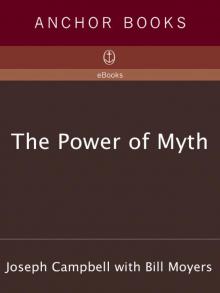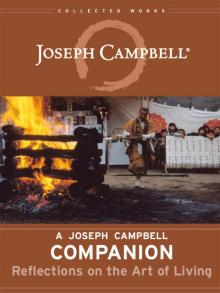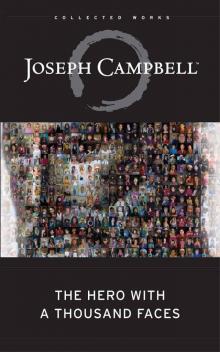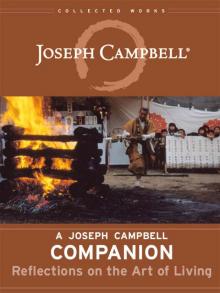- Home
- Joseph Campbell
Myths to Live By
Myths to Live By Read online
Myths to Live By
by
Joseph Campbell
Foreword by Johnson E. Fairchild
THE COLLECTED WORKS OF JOSEPH CAMPBELL
Copyright Notice
MYTHS TO LIVE BY
Copyright © 1972 by Joseph Campbell
Revised electronic edition copyright © 2011 by the Joseph Campbell Foundation (JCF)
All rights reserved.
No part of this work may be reproduced or transmitted in any form or by any means, electronic or mechanical, including photocopying, recording, or by any information storage and retrieval system, without permission in writing from the Joseph Campbell Foundation.
For information about this edition, see the Editor's Note.
For copyrights of quotations used, see the Acknowledgments section.
For sources and copyrights of images used, see the Illustration List.
Ebook by
tillpoint Digital Press
Thank you for maintaining this ebook for your personal use.
If you have received this book gratis, please join the JCF's associates in supporting our on-going efforts to bring out new, inspiring editions such as this by making a donation at JCF.org.
The Joseph Campbell Foundation is a registered 501(c) 3 United States not-for-profit corporation.
For further information, contact us on our website (www.jcf.org)
or at the following address:
Joseph Campbell Foundation
Post Office Box 36
San Anselmo CA 94979-0036
United States of America
ISBN 978-1-61178-000-0
About the Collected Works of Joseph Campbell
At his death in 1987, Joseph Campbell left a significant body of published work that explored his lifelong passion, the complex of universal myths and symbols that he called “Mankind’s one great story.” He also left, however, a large volume of unreleased work: uncollected articles, notes, letters, and diaries, as well as audio- and videotape-recorded lectures.
The Joseph Campbell Foundation (JCF)—founded in 1990 to preserve, protect, and perpetuate Campbell's work—has undertaken to create a digital archive of his papers and recordings and to publish The Collected Works of Joseph Campbell.
Robert Walter, Executive Editor
David Kudler, Managing Editor
THE COLLECTED WORKS OF JOSEPH CAMPBELL
The JCF has undertaken to make Mr. Campbell's unreleased and no-longer-available work—uncollected essays, journals, interviews, lectures, article fragments, etc—available through this thought-provoking series. The works in the on-going series are:
Print:
Thou Art That: Transforming Religious Metaphor—An exploration of the myths and symbols of the Judeo-Christian tradition
The Inner Reaches of Outer Space: Myth As Metaphor and As Religion—The last book that Campbell completed in his lifetime explores the nascent mythology of the modern age.
The Flight of the Wild Gander: Explorations in the Mythological Dimension—A collection of some of Campbell's most far-reaching essays
Baksheesh and Brahman: Asian Journals—India—The thoughtful diary of Campbell's life-changing trip to India
Sake and Satori: Asian Journals—Japan—The continuation of Campbell's 1955 trip, including his eye-opening experiences in Japan
Myths of Light: Eastern Metaphors of the Eternal—An exploration of the central myths and symbols of the great Asian religions
The Hero's Journey: Joseph Campbell on His Life and Work—A wonderful series of conversations between Campbell and many of his associates and friends
Mythic Worlds, Modern Words: Joseph Campbell on the Art of James Joyce—An exploration of the mythic impact of the twentieth century's greatest novelist
A Skeleton Key to Finnegans Wake—co-written with Henry Morton Robinson and newly edited by Joyce scholar Edmond Epstein, this remains the seminal analysis of Joyce's masterpiece
Pathways to Bliss: Mythology and Personal Transformation—In this work, Campbell explores myth as it pertains to the individual
The Mythic Dimension: Selected Essays 1959-1987—A new volume of Campbell's far-ranging, thought-provoking essays
The Hero with a Thousand Faces—A new edition of Campbell's classic exploration of the universal monomyth of the Hero Journey, and of its cosmic mirror, the Cosmogonic Cycle
Myths to Live By (ebook)—A newly illustrated and annotated electronic edition of this classic exploration of the philosophical, social and psychological affects of living myth
A Joseph Campbell Companion (ebook)—A new digital edition of one of Joseph Campbell's most popular and most quotable works
Video:
The Hero's Journey: A Biographical Portrait—This film, made shortly before his death in 1987, follows Campbell's personal quest—a pathless journey of questioning, discovery, and ultimately of delight and joy in a life to which he said, "Yes"
Sukhavati: A Mythic Journey—This hypnotic and mesmerizing film is a deeply personal, almost spiritual, portrait of Campbell
Mythos—This series is made up of talks that Campbell himself believed summed up his views on "the one great story of mankind"
Audio:
The Joseph Campbell Audio Collection, Series I—A newly digitized and remastered release of these classic recordings, covering Campbell's early years as a public speaker and including some of his most inspiring and beloved talks.
The Joseph Campbell Audio Collection, Series II
The Joseph Campbell Audio Collection, Series III—The JCF is preparing for the orderly release of sixty previously unavailable recordings of Campbell at his finest, exploring myth, religion, history, literature and personal growth as only he could.
Foreword
The seminal mind of Peter Cooper (1791–1883)—the radical, free-thinking inventor, moneymaker, and politician, the first real feminist of New York—conceived, among other great things, The Cooper Union for the Advancement of Science and Art. Cooper was disturbed by his own lack of education and by the knowledge that education was in his time conceived to be for the wealthy and for men alone. He changed both concepts, stimulated probably by the Chautauqua movement and the deeds of certain other philanthropists. His big and primary contribution was the idea of The Forum and adult education, which produced the first adult education college of this nation.
From the day of Abraham Lincoln’s address to the present, more than five thousand speakers and artists have appeared on the Great Hall platform, and their ideas have reached an audience of millions: an average of over a thousand people a night, three nights a week.
And today—thanks to Mr. Seymour Siegel’s nudging and the help of Mr. Bernard Buck—the offerings are being broadcast by the New York City municipal radio station, WNYC, to hundreds of thousands more. This already is the longest radio lecture series in history; and greatly to the credit of The Cooper Union is the fact that the director programing the lectures for The Forum—entrusted with the lonesome and awesome intellectual task of representing the past and looking into the future—has never once been interrupted in his work, directed, or interfered with by The Cooper Union.
One of my precepts during my twenty-two years at The Cooper Union has been that every one of the more than a thousand whom I have invited to speak or to perform, and have presented on the platform, should be my friend—as should also every member both of the visible audience and of the millions of invisible radio listeners. It would be difficult to select a single speaker; but Joseph Campbell, the author of the present book, epitomizes the quality of communication and intellectuality required for The Forum. He never uses a note, speaks beautifully, and is brilliant; above all, he transmits ideas that bridge the past and futur
e and the worlds of East and West. He has delivered at The Forum many great lectures and lecture series, and they have always been a joy and a pleasure. The present work, developed from those lectures, synopsizes a lifetime of scholarship and the best principles of The Cooper Union Forum. I am proud to be a part of this momentous book.
Johnson E. Fairchild
New York City,
October 15, 1971
Preface
From a series of some twenty-five talks on mythology delivered in The Great Hall of The Cooper Union Forum, New York City, between 1958 and 1971, I have here selected and arranged a baker’s dozen—Number Four being put together of parts of two from the same year. The topics and titles I owe to the fertile mind of Dr. Johnson E. Fairchild, the Chairman of The Forum, whose wit, wisdom, and personal charm kept that blithesome institution running for the best part of a quarter of a century. My continuing pleasure in lecturing there derived in part, of course, from the old-fashioned, simple grandeur of the Great Hall itself and the knowledge that Abraham Lincoln once spoke from the very stage on which I stood (a certain secret sense of participation in the grand stream of the history of American eloquence); but also, more immediately, from the mood and character of the open-eyed, open-hearted audiences that Dr. Fairchild managed to attract to his numerous series of free lectures and discussions in that friendly place. The question hours following the lectures, when he would amble with a microphone up and down the aisles, letting anyone who raised a hand say what he would in comment, query, or prepared oration, contributed more to my appreciation of the sheer fun of talking to people of good will about the topics of my own concern in terms appropriate to their concerns than any other experience of my years. And I hope that even in the more formal cast of the written prose of this book, something of the freshness and ease of my delight in delivering these talks will have been retained.
I am happy indeed that Dr. Fairchild has very kindly agreed to introduce the volume, as he introduced from the platform every one of its talks; the last, March 1, 1971, delivered (by the way) on the last evening before retirement of his long career as both Chairman of The Forum and Director of the Department of Adult Education of The Cooper Union. I think of this collection as an appropriate token of my debt and gratitude to him for the encouragement, warm friendship, and always timely suggestions of themes and titles that taught me to bring my Buffalo-Gods, Quetzalcoatls, Buddhas, and Fairy Queens into mutually illuminating dialogue with those hundreds of members of his audiences—many of them faithful for years—who finally were the inspiration for these talks. My thanks go out to them all as well as to their chairman.
I would thank, also, the technicians and officers of radio station WNYC for the tape-recordings from which I have prepared these chapters; Miss Marcia Sherman for her faithful typing and retyping of the many drafts, not only of these, but also of the lectures not here included; and my wife, Jean Erdman, for the idea, in the first place, of turning these talks into the chapters of a book, and the criticism and suggestions, then, that brought the book into being.
J. C.
New York City
July 4, 1971
I—The Impact of Science on Myth
Fig. 1.1 — Vitruvian Man
I
The Impact of Science on Myth
[1961]1
I was sitting the other day at a lunch counter that I particularly enjoy, when a youngster about twelve years old, arriving with his school satchel, took the place at my left. Beside him came a younger little man, holding the hand of his mother, and those two took the next seats. All gave their orders, and, while waiting, the boy at my side said, turning his head slightly to the mother, “Jimmy wrote a paper today on the evolution of man, and Teacher said he was wrong, that Adam and Eve were our first parents.”
My Lord! I thought. What a teacher!
The lady three seats away then said, “Well, Teacher was right. Our first parents were Adam and Eve.”
What a mother for a twentieth-century child!
The youngster responded, “Yes, I know, but this was a scientific paper.” And for that, I was ready to recommend him for a distinguished-service medal from the Smithsonian Institution.
The mother, however, came back with another. “Oh, those scientists!” she said angrily. “Those are only theories.”
And he was up to that one too. “Yes, I know,” was his cool and calm reply; “but they have been factualized: they found the bones.”
The milk and the sandwiches came, and that was that.
So let us now reflect for a moment on the sanctified cosmic image that has been destroyed by the facts and findings of irrepressible young truth-seekers of this kind.
At the height of the Middle Ages, say in the twelfth and thirteenth centuries, there were current two very different concepts of the earth. The more popular was of the earth as flat, like a dish surrounded by, and floating upon, a boundless cosmic sea, in which there were all kinds of monsters dangerous to man. This was an infinitely old notion, going back to the early Bronze Age. It appears in Sumerian cuneiform texts of about 2000 B.C.and is the image authorized in the Bible.
Fig. 1.2 — Planetary Spheres
The more seriously considered medieval concept, however, was that of the ancient Greeks, according to whom the earth was not flat, but a solid stationary sphere in the center of a kind of Chinese box of seven transparent revolving spheres, in each of which there was a visible planet: the moon, Mercury, Venus, and the sun, Mars, Jupiter, and Saturn, the same seven after which our days of the week are named.
The sounding tones of these seven, moreover, made a music, the “music of the spheres,” to which the notes of our diatonic scale correspond. There was also a metal associated with each: silver, mercury, copper, gold, iron, tin, and lead, in that order. And the soul descending from heaven to be born on earth picked up, as it came down, the qualities of those metals; so that our souls and bodies are compounds of the very elements of the universe and sing, so to say, the same song.
Music and the arts, according to this early view, were to put us in mind of those harmonies, from which the general thoughts and affairs of this earth distract us. And in the Middle Ages the seven branches of learning were accordingly associated with those spheres: grammar, logic, and rhetoric (known as the trivium), arithmetic, music, geometry, and astronomy (the quadrivium). The crystalline spheres themselves, furthermore, were not, like glass, of inert matter, but living spiritual powers, presided over by angelic beings, or, as Plato had said, by sirens. And beyond all, there was that luminous celestial realm where God in majesty sat on his triune throne; so that when the soul, at death, returning to its maker, passed again through the seven spheres, it left off at each the accordant quality and arrived unclothed for the judgment. The emperor and the pope on earth governed, it was supposed, according to the laws and will of God, representing his power and authority at work in the ordained Christian commonalty. Thus in the total view of the medieval thinkers there was a perfect accord between the structure of the universe, the canons of the social order, and the good of the individual. Through unquestioning obedience, therefore, the Christian would put himself into accord not only with his society but also with both his own best inward interests and the outward order of nature. The Christian Empire was an earthly reflex of the order of the heavens, hieratically organized, with the vestments, thrones, and procedures of its stately courts inspired by celestial imagery, the bells of its cathedral spires and harmonies of its priestly choirs echoing in earthly tones the unearthly angelic hosts.
Fig. 1.3 — Dante and Mt. Purgatory
Dante in his Divine Comedy unfolded a vision of the universe that perfectly satisfied both the approved religious and the accepted scientific notions of his time. When Satan had been flung out of heaven for his pride and disobedience, he was supposed to have fallen like a flaming comet and, when he struck the earth, to have plowed right through to its center. The prodigious crater that he opened thereupon became the fier
y pit of Hell; and the great mass of displaced earth pushed forth at the opposite pole became the Mountain of Purgatory, which is represented by Dante as lifting heavenward exactly at the South Pole.
In his view, the entire southern hemisphere was of water, with this mighty mountain lifting out of it, on whose summit was the Earthly Paradise, from the center of which the four blessed rivers flowed of which Holy Scripture tells.
And now it appears that when Columbus set sail across that “ocean blue” which many of his neighbors (and possibly also his sailors) believed was a terminal ocean surrounding a disk-like earth, he himself had in mind an image more like that of Dante’s world—of which we can read, in fact, in his journals. There we learn that in the course of his third voyage, when he reached for the first time the northern coast of South America, passing in his frail craft at great peril between Trinidad and the mainland, he remarked that the quantity of fresh water there mixing with the salt (pouring from the mouths of the Orinoco) was enormous. Knowing nothing of the continent beyond, but having in mind the medieval idea, he conjectured the fresh waters might be coming from one of the rivers of Paradise, pouring into the southern sea from the base of the great antipodal mountain. Moreover, when he then turned, sailing northward, and observed that his ships were faring more rapidly than when they had been sailing south, he took this to be evidence of their sailing now downhill, from the foot of the promontory of the mythic paradisal mountain.

 The Power of Myth
The Power of Myth A Joseph Campbell Companion: Reflections on the Art of Living
A Joseph Campbell Companion: Reflections on the Art of Living The Hero with a Thousand Faces
The Hero with a Thousand Faces Myths to Live By
Myths to Live By A Joseph Campbell Companion: Reflections on the Art of Living (Collected Works of Joseph Campbell)
A Joseph Campbell Companion: Reflections on the Art of Living (Collected Works of Joseph Campbell)